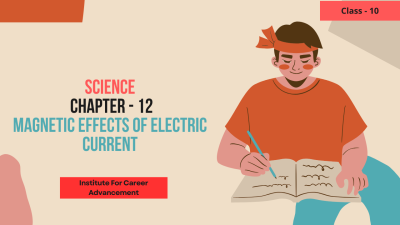Course description
This chapter explores the fascinating relationship between electricity and magnetism. You'll learn how flowing electric current creates an invisible force field called a magnetic field.
The course covers the following key topics:
Oersted's Experiment: This famous experiment conducted in 1820 by Hans Christian Oersted demonstrated for the first time that electric current can produce a magnetic field. You'll learn about the setup and the groundbreaking observation that a compass needle deflects near a current-carrying wire.
Magnetic Field and Field Lines: The magnetic field is a region around a current-carrying conductor where a magnetic force can be exerted. We use imaginary lines called magnetic field lines to visualize the direction and strength of the magnetic field. The closer the lines are, the stronger the field.
Right-Hand Thumb Rule: This rule helps determine the direction of the magnetic field around a current-carrying straight wire. By curling your thumb around the wire in the direction of current flow, your outstretched fingers point in the direction of the magnetic field lines.
Factors Affecting the Magnetic Field: The strength of the magnetic field produced by a current-carrying conductor depends on two main factors:
Current Strength: A stronger current produces a stronger magnetic field
Shape of the Conductor: Coiling the wire into a loop or solenoid concentrates the magnetic field lines, making the field stronger within the coil.
Applications of Magnetic Effect of Current: Electromagnets, which are temporary magnets made by coiling wire and passing current through it, have numerous applications. They are used in loudspeakers, electric motors, MRI machines, and many other technologies.
By understanding the magnetic effects of electric current, you gain a foundation for exploring electromagnetism, a crucial concept in modern physics and technology.
এই অধ্যায়টি বিদ্যুৎ এবং চুম্বকত্বের মধ্যে আকর্ষণীয় সম্পর্ক অন্বেষণ করে। আপনি শিখবেন কিভাবে প্রবাহিত বৈদ্যুতিক প্রবাহ একটি অদৃশ্য বল ক্ষেত্র তৈরি করে যাকে চৌম্বক ক্ষেত্র বলা হয়।
কোর্সটিতে নিম্নলিখিত মূল বিষয়গুলি অন্তর্ভুক্ত রয়েছেঃ
ওরস্টেডের পরীক্ষাঃ 1820 সালে হান্স ক্রিশ্চিয়ান ওরস্টেড পরিচালিত এই বিখ্যাত পরীক্ষাটি প্রথমবারের জন্য প্রদর্শন করেছিল যে বৈদ্যুতিক প্রবাহ একটি চৌম্বক ক্ষেত্র তৈরি করতে পারে। আপনি সেটআপ এবং গ্রাউন্ডব্রেকিং পর্যবেক্ষণ সম্পর্কে শিখবেন যে একটি কম্পাস সুই একটি তড়িৎ-বহনকারী তারের কাছে বিপথগামী হয়।
চৌম্বক ক্ষেত্র ও ক্ষেত্ররেখাঃ চৌম্বক ক্ষেত্র হল বিদ্যুৎ-বাহক পরিবাহী পরিবাহীর চারপাশের একটি অঞ্চল যেখানে চৌম্বক বল প্রয়োগ করা যেতে পারে। চৌম্বক ক্ষেত্রের দিক এবং শক্তি কল্পনা করতে আমরা চৌম্বক ক্ষেত্রের রেখা নামে কাল্পনিক রেখা ব্যবহার করি। লাইন যত কাছাকাছি হবে, মাঠ তত শক্তিশালী হবে।
ডান হাতের থাম্ব রুলঃ এই নিয়মটি বিদ্যুৎ বহনকারী সোজা তারের চারপাশে চৌম্বক ক্ষেত্রের দিক নির্ধারণ করতে সহায়তা করে। আপনার বুড়ো আঙুলটি তারের চারপাশে বিদ্যুৎ প্রবাহের দিকে ঘুরিয়ে, আপনার প্রসারিত আঙ্গুলগুলি চৌম্বক ক্ষেত্রের রেখার দিকে নির্দেশ করে।
চৌম্বক ক্ষেত্রকে প্রভাবিত করে এমন কারণগুলিঃ বিদ্যুৎ-বাহক পরিবাহী দ্বারা উৎপাদিত চৌম্বক ক্ষেত্রের শক্তি দুটি প্রধান কারণের উপর নির্ভর করেঃ
বিদ্যুৎ শক্তিঃ একটি শক্তিশালী বিদ্যুৎ একটি শক্তিশালী চৌম্বক ক্ষেত্র তৈরি করে।
কন্ডাক্টরের আকারঃ একটি লুপ বা সোলিনয়েডে তারটিকে কুণ্ডলী করা চৌম্বক ক্ষেত্রের রেখাগুলিকে ঘনীভূত করে, যা কুণ্ডলীর মধ্যে ক্ষেত্রটিকে আরও শক্তিশালী করে তোলে।
তড়িৎপ্রবাহের চৌম্বকীয় প্রভাবের প্রয়োগঃ তড়িৎ চুম্বক, যা কয়েলিং তার এবং তার মধ্য দিয়ে প্রবাহিত তড়িৎ প্রবাহ দ্বারা তৈরি অস্থায়ী চুম্বক, তার অসংখ্য প্রয়োগ রয়েছে। এগুলি লাউডস্পিকার, বৈদ্যুতিক মোটর, এমআরআই মেশিন এবং অন্যান্য অনেক প্রযুক্তিতে ব্যবহৃত হয়।
বৈদ্যুতিক প্রবাহের চৌম্বকীয় প্রভাবগুলি বোঝার মাধ্যমে, আপনি বৈদ্যুতিন চৌম্বকীয়তা অন্বেষণের জন্য একটি ভিত্তি অর্জন করেন, যা আধুনিক পদার্থবিজ্ঞান এবং প্রযুক্তির একটি গুরুত্বপূর্ণ ধারণা।



















